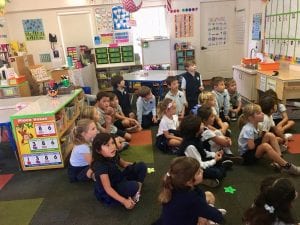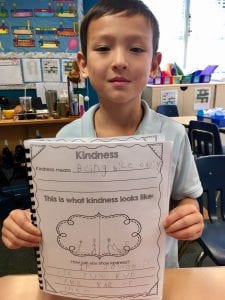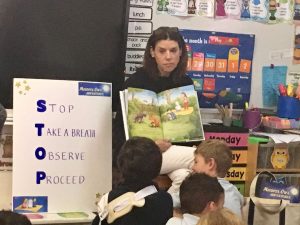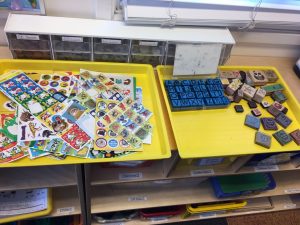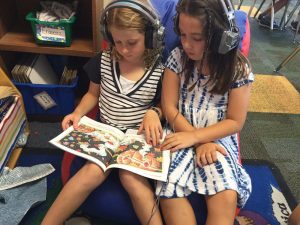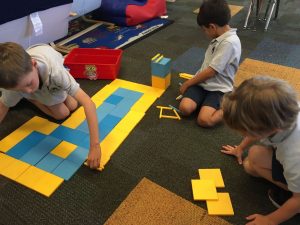
This poster hangs in our classroom.
A few years ago, our Kindergarten teacher and I collaborated to create a two year citizenship program for Kindergarten and first grade students. We named the program “Swooper Citizens” in honor of our school mascot, Swoop, who is an owl. Each week, we gather our students together for a focused lesson on a citizenship trait. So far this year, we have covered cooperation, courtesy, patience, confidence, and now this week, fairness. To read Mrs. Delwiche’s posts about some of our past lessons, click these links:
Cooperation
Patience
Confidence
To introduce the concept of fairness, we first asked the students, “What is the best way to share a cookie with one friend?” Students offered ideas such as just giving the cookie to their friend, buying another cookie, or splitting the cookie in half.
I then told the students that because they have been such great students this year, Mrs. Delwiche and I had decided to give each student a sticker. I began passing out a bright yellow happy face sticker to each student, but then, OOPS! I ran out! Three students were left without stickers!
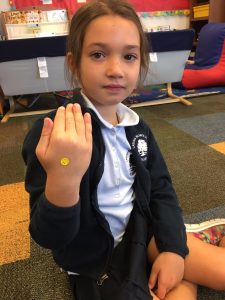
I asked the group if that seemed fair. They agreed that it wasn’t fair because everyone else had gotten a sticker. I then asked what would make it fair. This was where I was totally caught off guard. I fully expected students to suggest that I simply go get more stickers, but instead, several students immediately stood up and offered their stickers to the students who didn’t get them! This display of generosity and selflessness gave me chills. This is the fifth class I’ve used this lesson with, and I’ve never had students offer to give up their own “prize” completely. Way to go, students!

Giving a sticker away
Once I was able to gather my thoughts, I revealed to the students that I actually had three more stickers in my other pocket, so everyone was able to have one. We then talked about why I should give everyone a sticker, and settled on “Everyone gets treated the same” as our definition of fairness.
For now.
Next, I asked the students to close their eyes and think of a time when they got hurt. I asked them to remember what they were doing when it happened and what part of them was injured. Then I asked them to really focus in on what it felt like before they opened their eyes.
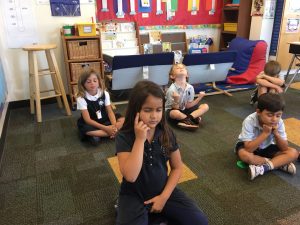
I called on a student to come up and share about a time he was hurt. After he shared about a skinned knee, I gave him a bandaid “to help his hurt knee.” I called on other students to come up and share. We heard about bumped foreheads, scraped elbows, and twisted ankles. Each time, I gave the student a bandaid on his or her knee to help. Several students said, “But Mrs. Vanetti, my hurt was on my face/elbow/ankle!” And I simply responded, “Yes, I heard. I’m so sorry you got hurt!”

Pointing to our “injuries”
Finally, someone said, “Why do you keep giving everyone a bandaid on their knee, if that’s not where everyone got hurt?” I responded that we were learning about fairness and we had just said that being fair meant that everyone got the same treatment. Since I had given the first person a bandaid on their knee, I wanted to be fair and treat everyone the same.
“But it’s still not fair. I don’t need a bandaid on my knee!”

Perfect. This launched a great conversation where we decided that maybe sometimes fairness isn’t about getting the same thing. We decided that often, the true definition of fairness means everyone gets what they need. We talked about ways we see this at school, including how first graders study different spelling words or read different books. (We also gave some silly examples such as if one person needed to use the restroom and the teacher made everyone go even if they didn’t need to.)
The students gave some great examples of both definitions of fairness.

“If you need a bandaid in different spots you should get it in that spot.”
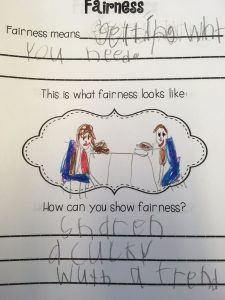
“Sharing a cookie with a friend”

“Not cutting in line”
Next week, we will continue with the important concept of forgiveness!

